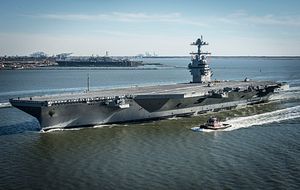The U.S. Department of Defense (DoD) is continuing to evaluate a proposal put forward by the U.S. Navy to procure two nuclear-powered Gerald R. Ford-class aircraft carriers under one contract as a cost- and time-saving measure.
“We are conducting an evaluation to ensure we have the warfighting capabilities to compete and win,” U.S. Deputy Defense Secretary Pat Shanahan was quoted as saying by Bloomberg News on October 19. “Any decision will factor in strengthening the industrial base and delivering best value for taxpayers.”
While U.S. Congress approved the block procurement in the 2019 National Defense Authorization Act, U.S. ship maker Huntington Ingalls Industries – Newport News Shipbuilding (HII-NNS), the Ford-class’ builder, has far failed to meet the U.S. Navy’s cost-cutting requirements. According to one U.S. Navy estimate, the service would save around $2.5 billion with a single buy.
“We are trying to get [the savings] higher,” a Navy spokesman said in an email to Bloomberg News, adding that “we expect to have a decision in mid-fall.”
In March, the U.S. Navy released a Request for Proposal to HII-NNS in order to “further define the cost savings achievable with a two-ship buy,” according to a statement. The entire Ford carrier program has been plagued by delays and cost overruns, as I stated elsewhere:
Controlling the cost of the Ford-class program has been a big challenge for the U.S. Navy, with cost overruns around $2.3. billion so far. The first-of-class USS Gerald R. Ford (CVN-78), commissioned in July 2017, is already the U.S. Navy’s most expensive warship in its history, with total cost amounting to almost $13 billion. The per-unit cost of the remaining ships of the class is estimated at around $10 billion.
As a consequence of the multiyear delays and to expedite the deployment of the first-of-class Gerald R. Ford, the U.S. Navy considered cancelling shock trials in 2017, a move that was calculated to move up the combat deployment of the USS Gerald R. Ford by a year from 2022 to 2021. For the time being, the USS Gerald R. Ford is scheduled for its first operational deployment in 2022.
The Ford’s follow-on, the future USS John F. Kennedy (CVN-79), will likely be commissioned in 2020. The third ship of the class, USS Enterprise (CVN-80), is expected to join the fleet by 2027. The fourth, as yet unnamed, Ford-class carrier (CVN-81) is slated to join the U.S. Navy by 2029 or 2030. The service intends to deploy a total of 12 Ford-class aircraft carriers, up from the 11 carriers in service today.































